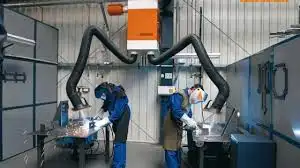Many work processes create harmful contaminants in the air, and these can be breathed in by employees and others in the building. Local exhaust ventilation, also known as LEV, is a system that transports contaminants in the air away from breathing zones to reduce workplace exposures to harmful contaminants.
Using this type of ventilation will protect from respiratory damage when the air would otherwise be dangerous to breathe. Keep reading to learn more about the types of local exhaust ventilation, components of LEV systems, and why you need them.
Why Do You Need Local Exhaust Ventilation?
There are several reasons that you need to install LEV systems in your workplace. Aside from the main benefit of keeping your employees safe, there are laws that require you to create a healthy working environment. By using an LEV system, you will create a safer working environment for your employees.
Laws
If your business creates dust or other contaminants that go into the air, you are required by law to protect your employees. An LEV system takes harmful contaminants out of the air, reducing the chances of bad air quality and making it a safer place for your employees to work.
Safety
Some types of work emits fumes, vapours, and other hazardous particles into the air. If the work process itself cannot be charged to reduce the contamination produced then local exhaust ventilation is the best way to reduce exposure to airborne nanoparticles. RPE should be the last resort for user protection.
There are many dangerous particulates that workers can be exposed to. For example, workers can even have problems that come from breathing in flour dust, paint fumes, and more. These types of particles are well established causes of health problems, such as asthma, lung cancer, or other types of lung diseases.
Long Term Benefits of LEV Systems
One of the long-term benefits of installing an LEV system in your workplace is that it will keep your employees safe and lower their risk of getting lung diseases. It will also improve the safety of your work environment.
Types of Local Ventilation
Enclosing Hood
In this ventilation system, the hood surrounds the place where contaminants or particles come from. This also includes partially enclosed hoods, which only block off two or three sides of the area.
Receiving Hood
A receiving hood is located above the source of emissions. It is located at the place where the contaminant is generated and receives the contaminant through a high rate of airflow.
Capturing Hood
The system has a high enough airflow to draw in contaminated air. Essentially, this type of ventilation removes the unhealthy particles from the air by pulling the air, along with the hazardous particles, into the hood.
There are many types of capturing hoods. These include movable, fixed, portable, and more.
LEV Components
There are many parts that make up the local exhaust ventilation system. These include the hood, ducting, filter or air cleaner, fan, and exhaust stack. Each of these components play a vital role in maintaining good air quality for your employees and helps keep harmful particles out of the air.
Hood
The main part of an LEV system is the hood. This is the part of the ventilation system that captures the contaminated air.
To be effective, it should be close to the source of contaminants and should enclose the work area when possible. If it doesn’t enclose the area, there is a chance that the contaminated air can be blown into the workplace. This would defeat the purpose of an LEV system.
Ducting
Contaminated air uses the ducting to travel through to get to the air cleaner or filter. It is important to maintain the ducting of an LEV system, as a build-up of dust can lead to reduced system performance, fires, explosions or duct collapses.
Filter
This is a vital part of the LEV system as the filter is what cleans the air that has been contaminated.
Make sure that the filter works for the type of contaminant in your work area and that it is not difficult to be cleaned or replaced. This will make LEV maintenance much easier. When you get your LEV tested, this is one of the things that will be checked. Make sure that there is no damage to your air cleaner.
Fan
The fan is what moves the contaminated air through the entire LEV system. It will take the air from the hood, through the ducts, and to the exhaust stack. Fans should have a good enough flow to move the particles and to take them through the system.
Choosing the right type and size of fan is important to make your LEV system function properly.
Exhaust Stack
An exhaust stack is the final destination of the LEV system. This is where the contaminated air goes outside. Be sure that you follow the safety guidelines to make sure you place your exhaust stack safely away from neighbouring buildings or public areas.
LEV Testing Service
LEVs come with health and safety risks, so it is important to regularly test them. LEV testing is mandatory and is used for any type of equipment that captures dust or dangerous particles in a work environment. You undertake a thorough inspection and test to check your LEV system every 14 months.
At Ventilation Surveys and Services Ltd we offer LEV testing nationwide, so contact us today if you need help testing your HVAC systems or if you need the services of an HVAC contractor.
Learn More About Ventilation Surveys & Services Today!
Making sure you do your research before installing a ventilation system is important. If you have any questions about the types of LEV systems available, any duct cleaning or HVAC maintenance services, contact us today!

